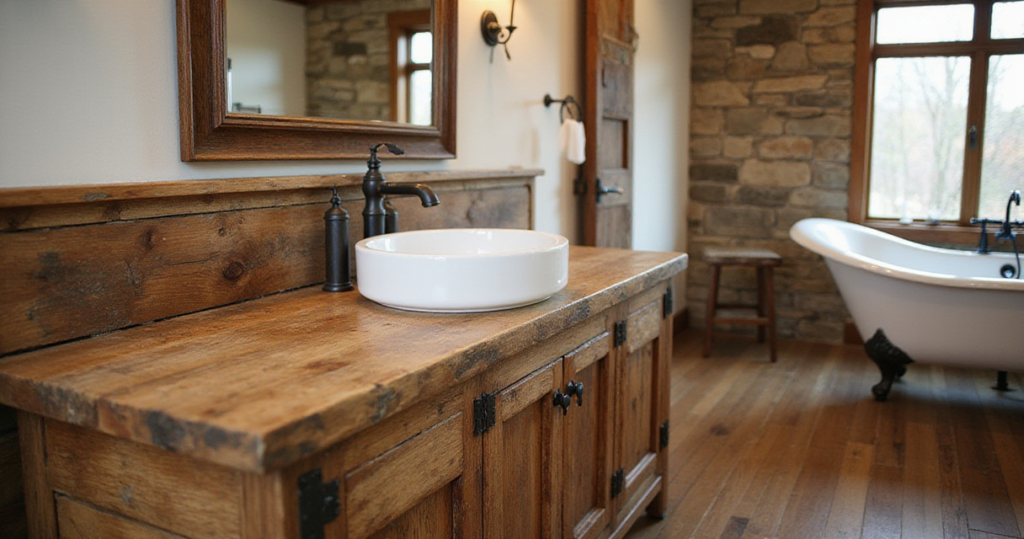In a world constantly buzzing with technology and sleek minimalism, there’s something deeply comforting about retreating to a space that feels grounded and authentic. The bathroom—often overlooked as merely functional—offers the perfect canvas for creating a personal sanctuary that bridges cultural design traditions.
As someone who has spent years studying the intersection of Eastern and Western design principles, I’ve found that rustic bathroom decor provides a unique opportunity to blend these diverse influences. The raw textures, natural materials, and imperfect beauty of rustic style create a universal language that transcends cultural boundaries.
These 22 ideas will guide you through transforming your bathroom into a tranquil retreat that honors both heritage and personal style. Whether you’re drawn to the weathered wood of Western farmhouses or the organic simplicity of Eastern design philosophy, you’ll find inspiration to create a space that tells your unique story.
1. Embrace the Warmth of a Reclaimed Wood Vanity
The vanity often serves as the centerpiece of bathroom design, and choosing one crafted from reclaimed wood instantly establishes a rustic foundation. These pieces carry inherent character through their natural imperfections—knots, nail holes, and saw marks that speak to their previous lives. Beyond aesthetic appeal, reclaimed wood represents an environmentally conscious choice that gives historical materials new purpose.
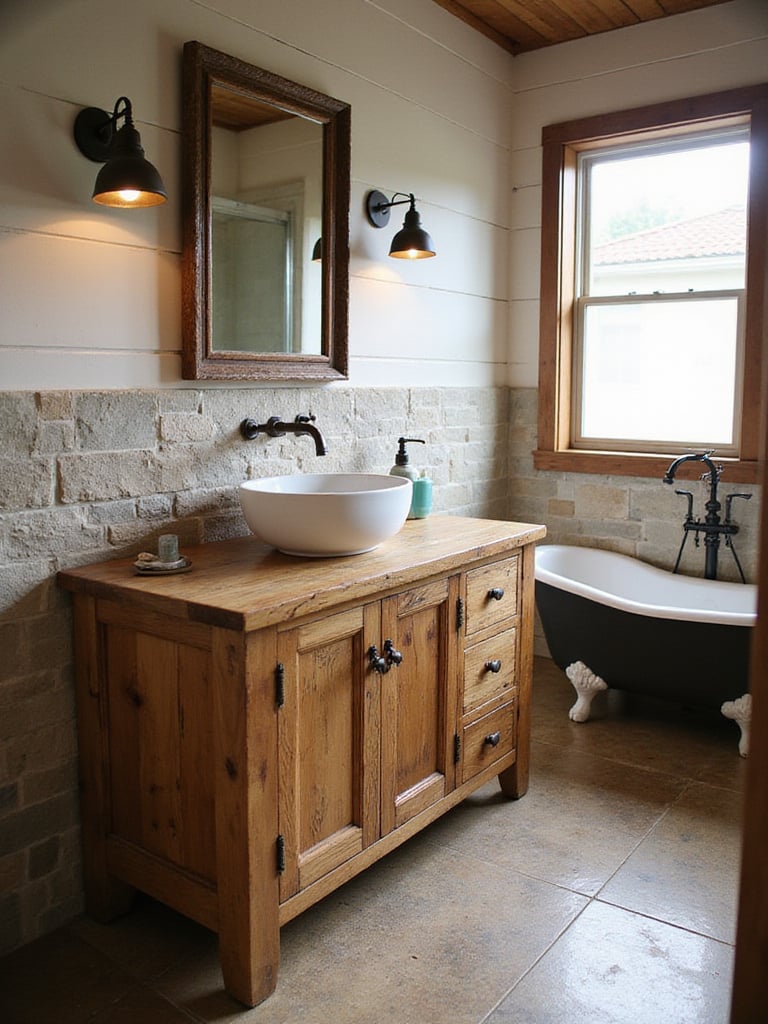
In bathroom environments, proper sealing is essential. Depending on your desired look, options range from marine-grade sealants to polyurethanes or epoxies. Even when paired with a separate countertop, the wood structure requires thorough protection against moisture through quality sealers or varnishes applied in multiple coats.
The inspiration for this collection struck when I visited a traditional Japanese bathhouse that had incorporated elements from an old European farmhouse. The contrast between the sleek stone basin and the richly textured reclaimed elm vanity created a dialogue between cultures that felt both fresh and timeless.
2. Install a Natural Stone Sink for Earthy Appeal
A natural stone sink brings an undeniable connection to the earth, creating perfect harmony with wooden elements in rustic bathroom decor. Each stone type offers distinct characteristics—river rock with its naturally rounded exterior and polished interior basin; travertine with warm, porous textures; or honed granite and marble for a more refined rustic approach.
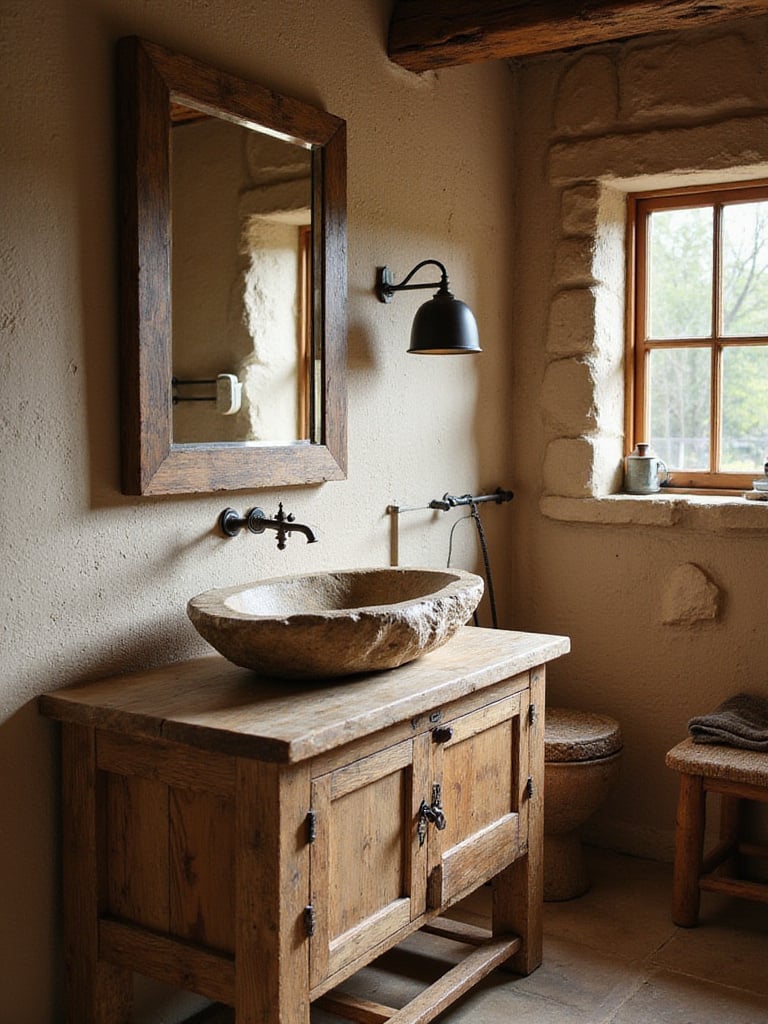
These sinks provide unparalleled beauty through unique patterns—no two are identical—and exceptional durability when properly maintained. However, their porous nature necessitates regular sealing to prevent staining and etching, and their substantial weight requires proper structural support.
The magic of this piece lies in how it bridges Eastern and Western design sensibilities. While stone basins have been used in European farmhouses for centuries, they also evoke the minimalist stone elements found in traditional Japanese gardens—a perfect cross-cultural design element for rustic bathroom decor.
3. Create an Accent Wall with Barn Wood or Shiplap
Adding textured accent walls using barn wood or shiplap introduces dimensional character that plain painted surfaces simply cannot achieve. Barn wood, with its weathered appearance and unique color variations, tells a story through its imperfections. Shiplap, featuring overlapping boards with distinctive gaps, provides a cleaner yet still textured look that references both American farmhouses and the clean lines of Scandinavian design.
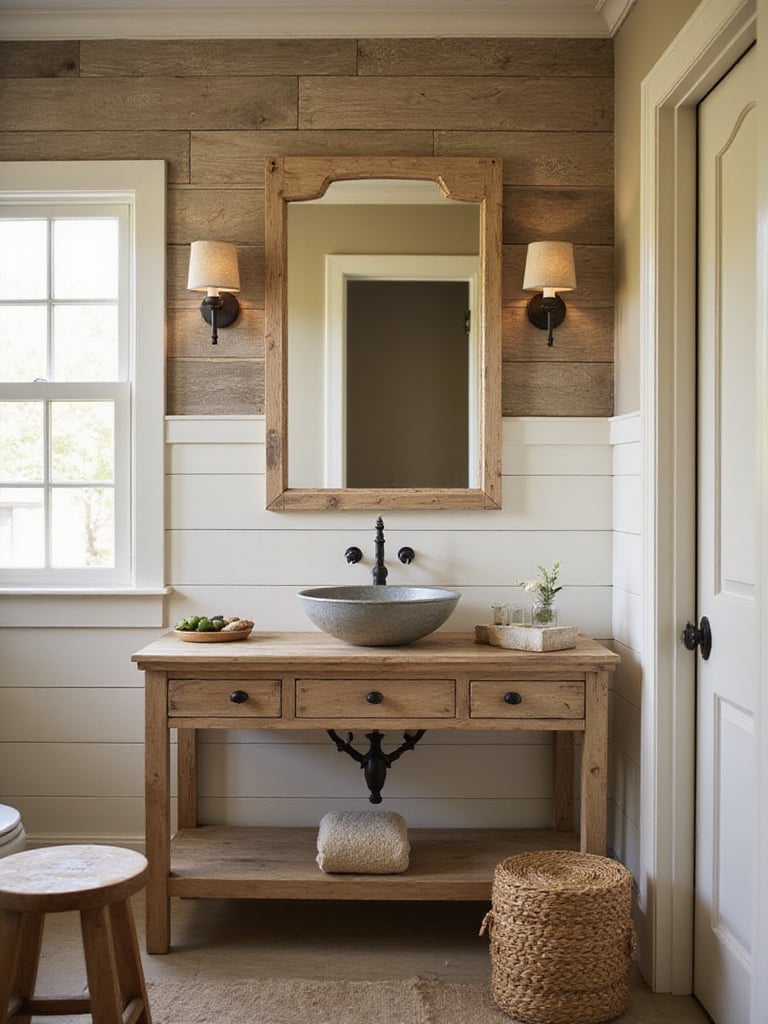
When using real wood in moisture-rich environments, proper preparation is essential. Source thoroughly dried and treated wood, apply high-quality moisture-resistant sealant to all surfaces before installation, and ensure adequate ventilation. Alternatively, engineered wood or PVC products designed specifically for bathrooms offer similar aesthetics with enhanced durability.
What makes this design special is the way it can incorporate cultural influences from both hemispheres. Consider using reclaimed wood from local sources that reflect your region’s architectural heritage, creating a meaningful connection to place within your rustic bathroom decor.
4. Illuminate with Mason Jar or Industrial Lighting
The right lighting dramatically enhances rustic bathroom decor, setting the mood and highlighting textural elements. Mason jar fixtures evoke vintage charm and simplicity, their clear glass allowing warm bulb glow to create an inviting atmosphere. These humble vessels, associated with preservation and country living, connect naturally to rustic aesthetics.
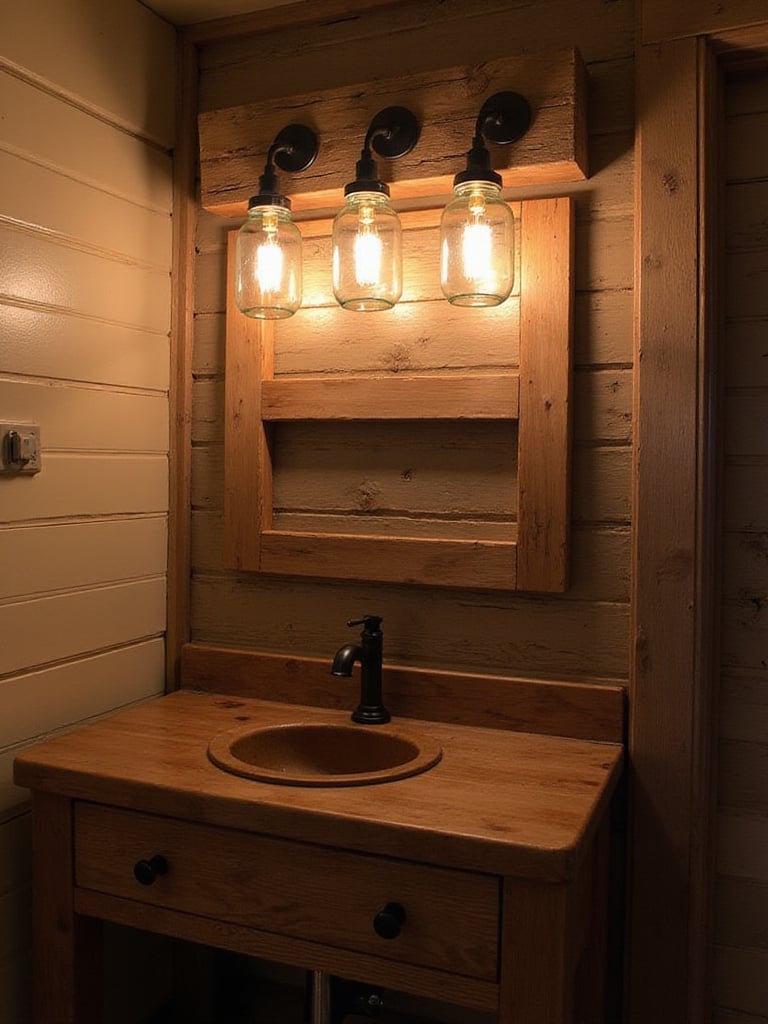
Industrial lighting with exposed metal, utilitarian designs, and visible hardware provides compelling contrast that enhances rustic elements. This juxtaposition—rough-hewn wood alongside sleek metal fixtures—creates visual interest and authentic character. For bathroom installations, always select fixtures rated for damp or wet locations and consult qualified electricians for safe installation.
The artisans behind these designs began with traditional forms but reimagined them for contemporary spaces. I’ve found that mixing Eastern-inspired paper lanterns with Western industrial elements creates an unexpected harmony in rustic bathroom decor that honors both traditions while creating something entirely new.
5. Hang a Distressed or Farmhouse-Style Mirror
Mirrors serve essential functions while offering opportunities to enhance character through thoughtful selection. Distressed or farmhouse-style mirrors typically feature frames made from natural or reclaimed wood with visibly aged, weathered finishes—perhaps chipped paint, prominent grain, or metal accents with developed patina.

These mirrors embody core rustic design principles: natural materials, celebrated imperfections, historical references, and inherent warmth. They prevent sterility through textural interest and complement other rustic elements like wood vanities or vintage fixtures. Common materials include reclaimed barn wood, salvaged lumber, rough-sawn pine, or aged metals that add tactile depth and visual interest.
The silhouette draws inspiration from both European farmhouse traditions and the wabi-sabi philosophy of Japanese design, which finds beauty in imperfection. This cross-cultural approach to rustic bathroom decor allows you to create spaces that feel both grounded in tradition and freshly relevant.
5. Add Classic Charm with a Clawfoot Tub
Nothing evokes vintage character quite like a clawfoot tub. These statement pieces reference history, craftsmanship, and simpler times—perfectly aligning with rustic bathroom decor principles. Their freestanding form creates beautiful contrast with natural wood, stone, and raw materials, while visible plumbing and vintage-inspired faucets enhance authentic character.
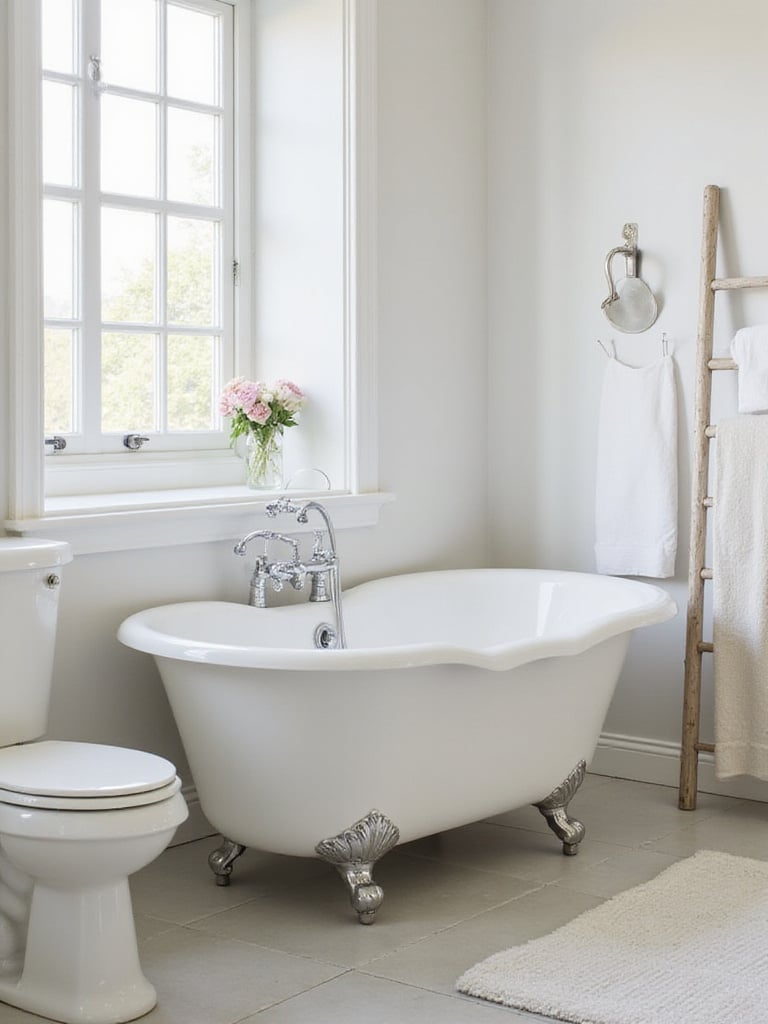
Traditional clawfoot tubs are cast iron with porcelain enamel interiors, offering exceptional durability. Copper provides another excellent option with its warm patina development. Installation differs significantly from built-in models, requiring freestanding plumbing and adequate structural support, particularly for heavier cast iron versions.
The environmental story behind this piece began centuries ago when these tubs represented the height of luxury bathing. Today, restoring vintage clawfoot tubs not only creates stunning rustic bathroom decor but also represents sustainable design through preservation rather than new production—honoring both Eastern principles of respect for materials and Western appreciation for historical craftsmanship.
7. Incorporate Distressed Finishes on Furniture or Walls
Distressed finishes—techniques that create aged, worn appearances—perfectly complement rustic bathroom decor. Methods include strategic sanding, intentional nicks, or specialized washes that mimic natural aging processes. These approaches evoke history and authenticity while celebrating imperfection—core elements of rustic style that make spaces feel lived-in and genuine.

In high-moisture bathroom environments, careful application is essential. Ideal candidates include properly sealed solid wood vanities, mirror frames, open shelving, and decorative wall elements. Larger pieces make significant impact statements, while smaller items add subtle character touches. All applications require appropriate sealing against moisture.
The unexpected environmental benefit comes from how these techniques can transform inexpensive or damaged pieces into charming features for rustic bathroom decor. This approach honors both the Western tradition of adaptive reuse and the Eastern philosophy of finding beauty in imperfection and repair—creating cultural bridges through design.
8. Utilize Open Shelving with Pipe or Wood Brackets
Open shelving creates accessible storage while maintaining spacious feel—particularly valuable in smaller bathrooms. When supported by industrial pipes or substantial wood brackets, these elements perfectly embody rustic bathroom decor principles through natural materials, raw textures, and components that feel handcrafted or repurposed.
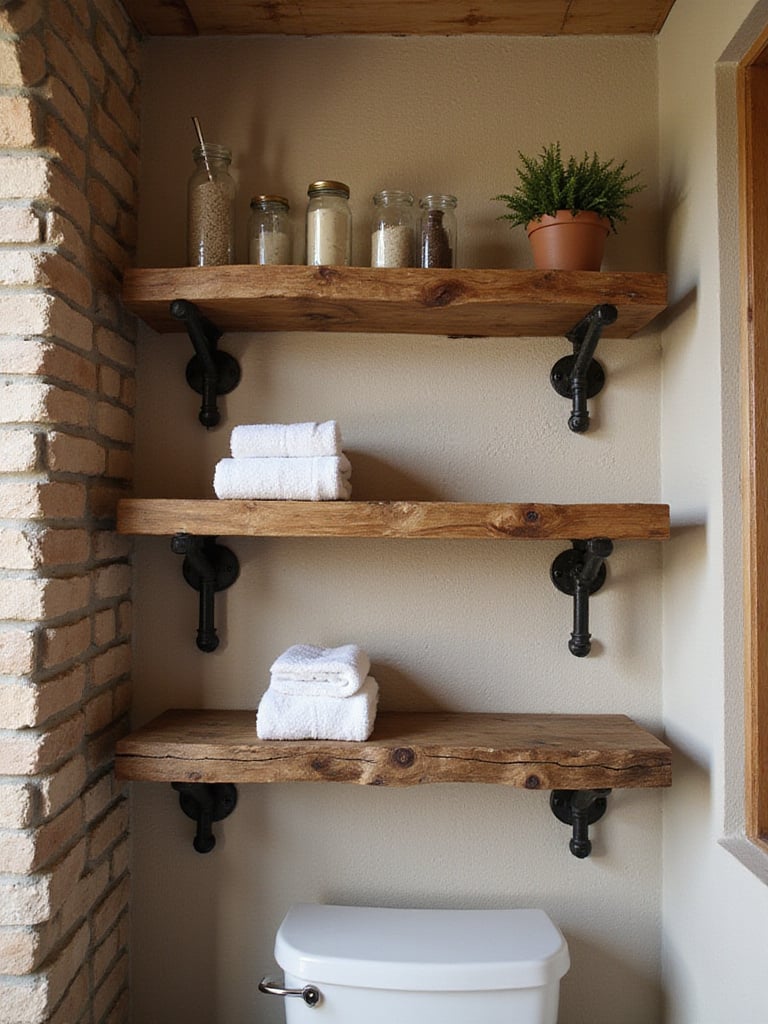
For authentic rustic character, choose wood with natural personality—reclaimed barn boards or rough-sawn pine—and finish with protective but visually subtle treatments like matte waterproof sealants or light stains. Avoid high-gloss finishes that contradict rustic aesthetics. Ensure proper sealing against moisture and secure installation into wall studs or with heavy-duty anchors for safety and stability.
Beyond the obvious placement, consider using these shelving elements to display cultural artifacts that reflect your heritage or travels. In my own designs, I often incorporate small Eastern ceramics alongside Western vintage bottles, creating meaningful rustic bathroom decor that tells a personal story of cultural appreciation.
9. Choose Wrought Iron or Matte Black Fixtures
Hardware finishes significantly impact rustic bathroom decor, with wrought iron and matte black options providing perfect complementary elements. These finishes evoke craftsmanship heritage and grounded authenticity. Wrought iron’s hand-forged appearance and subtle textural variations speak to traditional techniques, while matte black provides bold, non-reflective contrast that highlights natural elements.
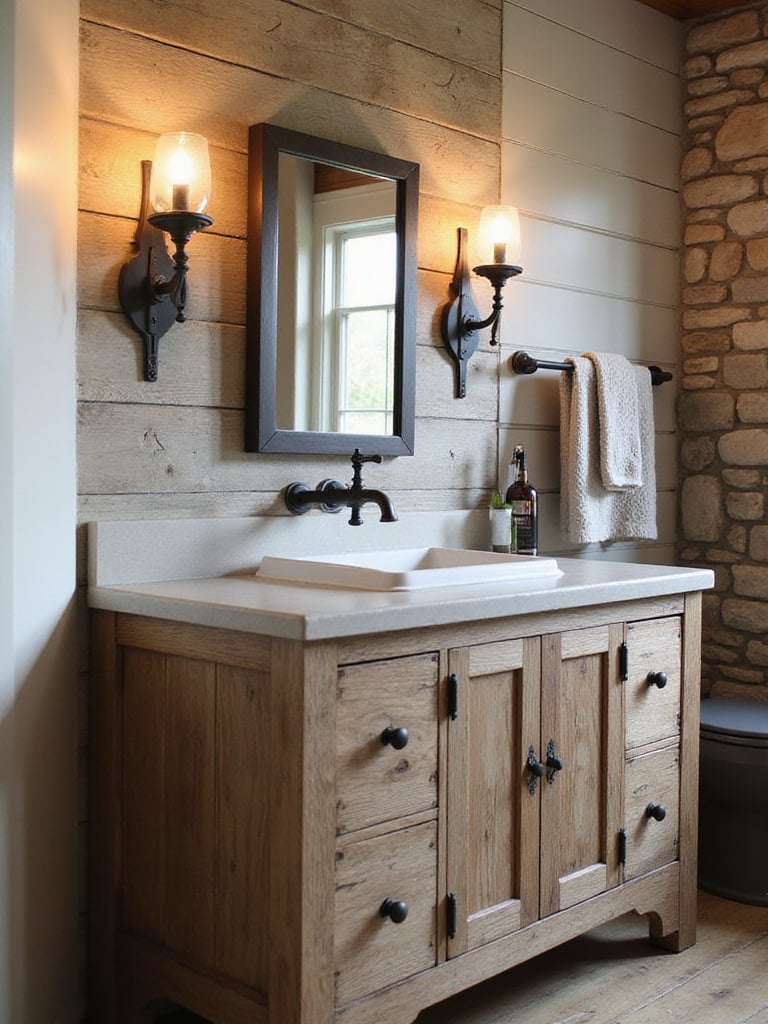
These finishes work beautifully across numerous bathroom fixtures—faucets, showerheads, cabinet hardware, towel bars, hooks, lighting, and mirror frames—creating cohesive visual language. Practical benefits include reduced visibility of water spots and fingerprints while providing strong visual anchoring that allows other rustic elements to shine.
The heritage technique gets a contemporary update through modern manufacturing processes that maintain traditional appearances while improving durability in bathroom environments. This balance between honoring craft traditions and embracing practical innovations represents the best of both Eastern and Western approaches to rustic bathroom decor.
10. Layer in Natural Textures Like Burlap or Cotton
Introducing natural fiber textures adds essential warmth and depth to rustic bathroom decor. Burlap, with its coarse, unrefined weave, brings immediate rustic authenticity and raw appeal. Cotton, particularly in textured forms like waffle weave or terrycloth, contributes softness and comfortable simplicity. Together, these materials create tactile interest and visual depth that ground spaces in natural elements.

Incorporate these textures thoughtfully through cotton towels, bath mats, and shower curtains with interesting weaves. Burlap works beautifully for decorative elements like storage basket liners or framed artwork. For practical bathroom applications, cotton excels through moisture absorption and washability, while burlap should remain in drier areas to prevent mold development.
The traditional methods used result in textiles that connect us to generations of craftspeople across cultures. When selecting textural elements for rustic bathroom decor, consider how Eastern and Western textile traditions can complement each other—perhaps pairing Japanese cotton towels with European burlap accents for a globally-inspired yet cohesive look.
11. Paint Walls in an Earthy Color Palette (Greens, Browns, Grays)
Rustic bathroom decor fundamentally connects to nature, with earthy wall colors reinforcing this relationship. Muted greens, warm browns, and soft grays directly reference natural elements—forests, soil, stones, and weathered surfaces. These colors establish groundedness and tranquility while providing serene backdrops that beautifully complement natural textures and materials.
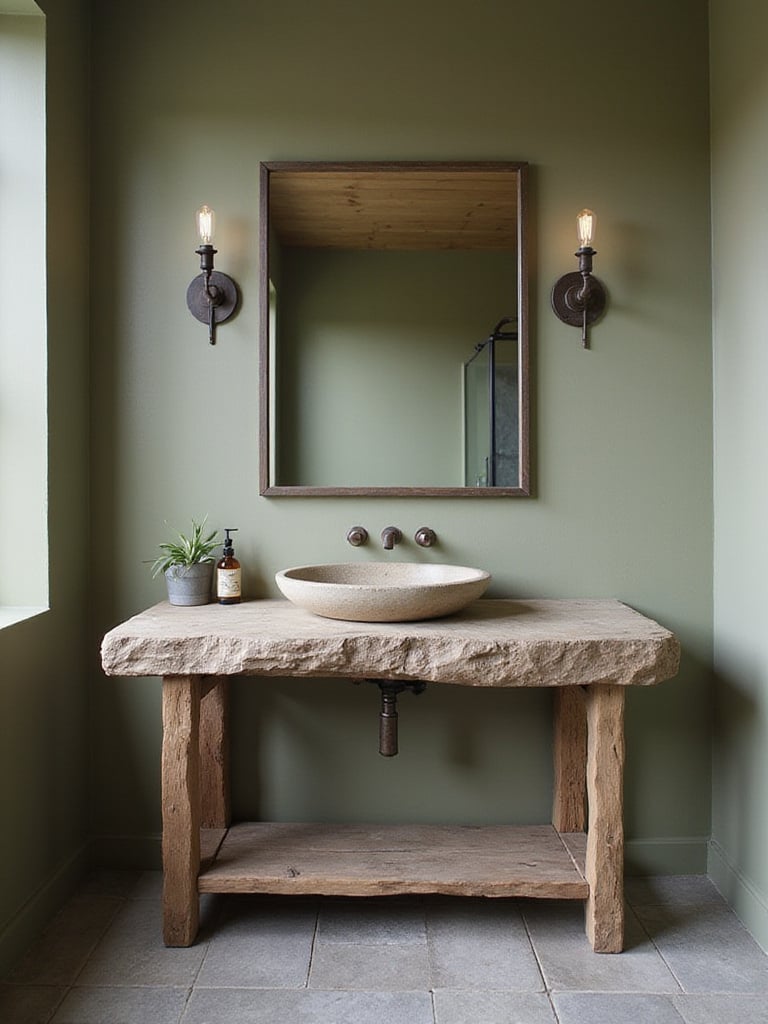
Different shades within these palettes create subtle mood variations. Muted greens like sage or olive evoke foliage and tranquility. Rich browns such as taupe or tan reflect soil and wood, adding warmth. Soft grays mimic natural stone and weathered surfaces, providing neutral grounding. Slightly desaturated shades enhance the natural, lived-in qualities characteristic of rustic style.
The cultural heritage preserved in each piece includes color traditions from around the world. In my design practice, I often draw from both Eastern and Western color philosophies—perhaps the earthy red-browns of Japanese architecture alongside the sage greens of American craftsman traditions—creating rustic bathroom decor that feels both globally inspired and harmoniously balanced.
12. Introduce Subtle Antler or Nature-Inspired Decor
Natural elements like antlers (ethically shed by animals) create immediate connections to wilderness settings, making them perfect accents for rustic bathroom decor. Their organic shapes and earthy textures contribute warmth and authenticity. Beyond antlers, incorporating wood, stone, leaf motifs, or wildlife references brings natural tranquility indoors, transforming utilitarian bathrooms into serene retreats.

Subtlety prevents overwhelming the space. Consider smaller, functional applications: a single shed antler as shelf decor, branch-shaped hardware, twig-framed mirrors, stone soap dispensers, botanical prints, or nature-patterned textiles. Even small elements like water-safe plants or river stone collections add elegant natural touches without domination.
For those hesitant about bold patterns, nature-inspired elements offer a more subtle way to add character to rustic bathroom decor. Try incorporating just one or two carefully selected pieces that reference the natural world, creating focal points that draw the eye without overwhelming the space.
13. Hang Vintage or Rustic Signs for Personality
Rustic and vintage signs inject personality and historical references into bathroom spaces. These typically feature distressed wood, aged metal, or canvas with weathered appearances suggesting history and character. Messages range from humorous bathroom phrases to general rustic themes, vintage advertising styles, or directional signage.

Strategic placement maximizes impact—above toilets, on blank walls opposite vanities, or leaning on shelves. Grouping varied sizes and materials creates interesting focal points or gallery effects. Consider sign scale relative to wall space and room dimensions for balanced composition within your rustic bathroom decor scheme.
When clients ask us about balancing style with comfort, we often suggest personalized signage as an easy way to inject character into rustic bathroom decor. These elements can reference family history, travel memories, or cultural sayings that make the space uniquely yours while maintaining cohesive design language.
14. Consider a River Rock or Pebble Tile Shower Floor
Shower floors featuring river rock or pebble tiles bring authentic natural elements into rustic bathroom decor. Made from actual stones smoothed by water, these materials provide unique organic textures and appearances that manufactured options cannot replicate. Their irregular shapes, color variations, and tactile qualities create grounding elements that complement wood, stone, and other natural features.
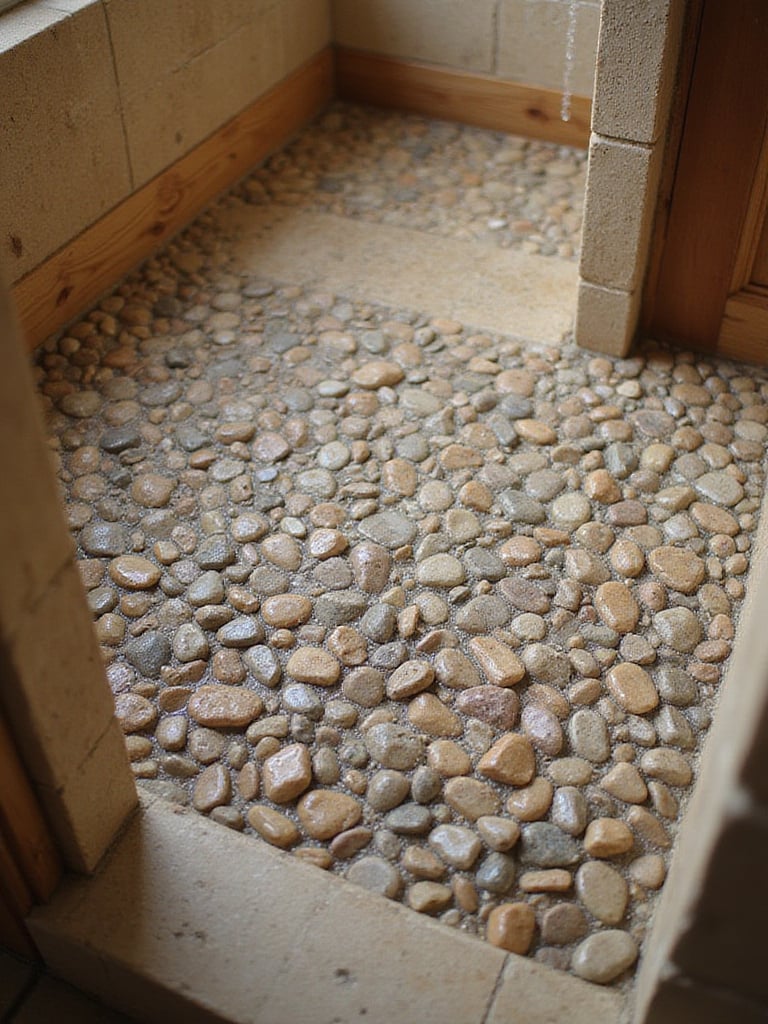
These tiles offer striking visual appeal and excellent slip resistance while providing unique sensory experiences underfoot. However, they require more grout than standard tiles, necessitating regular sealing of both stones and grout to prevent staining and mold growth. The uneven surface, while massaging, might be uncomfortable for some users.
Running your hand across this material reveals subtle variations in each stone’s texture and temperature—a sensory experience that connects us to natural landscapes. In rustic bathroom decor, these elements can reference both Eastern bathing traditions that emphasize connection to nature and Western appreciation for natural materials, creating cross-cultural design harmony.
15. Feature Live Edge Wood Countertops or Shelves
Live edge wood—incorporating the natural, untrimmed edge of tree slabs—preserves organic forms that highlight natural grain patterns and beautiful imperfections. For rustic bathroom decor, these elements create powerful connections to nature through their raw, earthy authenticity and handcrafted uniqueness. Each piece tells its own story through distinctive characteristics that become natural focal points.
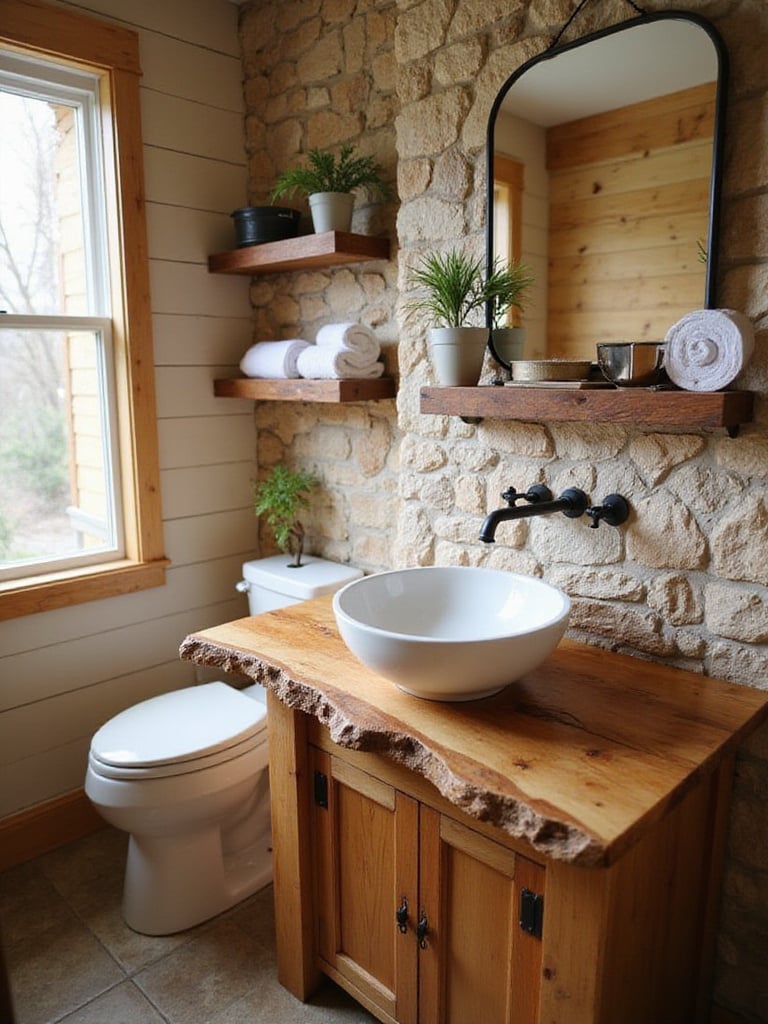
Hardwoods like walnut, oak, or maple work best for bathroom applications when properly prepared. Live edge wood must be thoroughly dried (preferably kiln-dried) and sealed with high-quality waterproof finishes like marine-grade varnishes or epoxy resins. Multiple protective coats on all surfaces prevent moisture damage, warping, and cracking—critical considerations for bathroom installations.
The designer’s secret here is to balance the organic, flowing lines of live edge wood with more structured elements in your rustic bathroom decor. This creates a dialogue between the wild and the ordered that reflects both Eastern design philosophy’s respect for natural forms and Western traditions of craftsmanship—a perfect cross-cultural approach.
16. Bring Warmth with Copper Accents or Fixtures
Copper provides exceptional warmth through its rich, reddish-brown tones and unique patina development that adds character and perceived age. Unlike sterile chrome or nickel, copper’s living finish evolves naturally, creating inviting authenticity that perfectly complements rustic bathroom decor through historical and handcrafted associations.
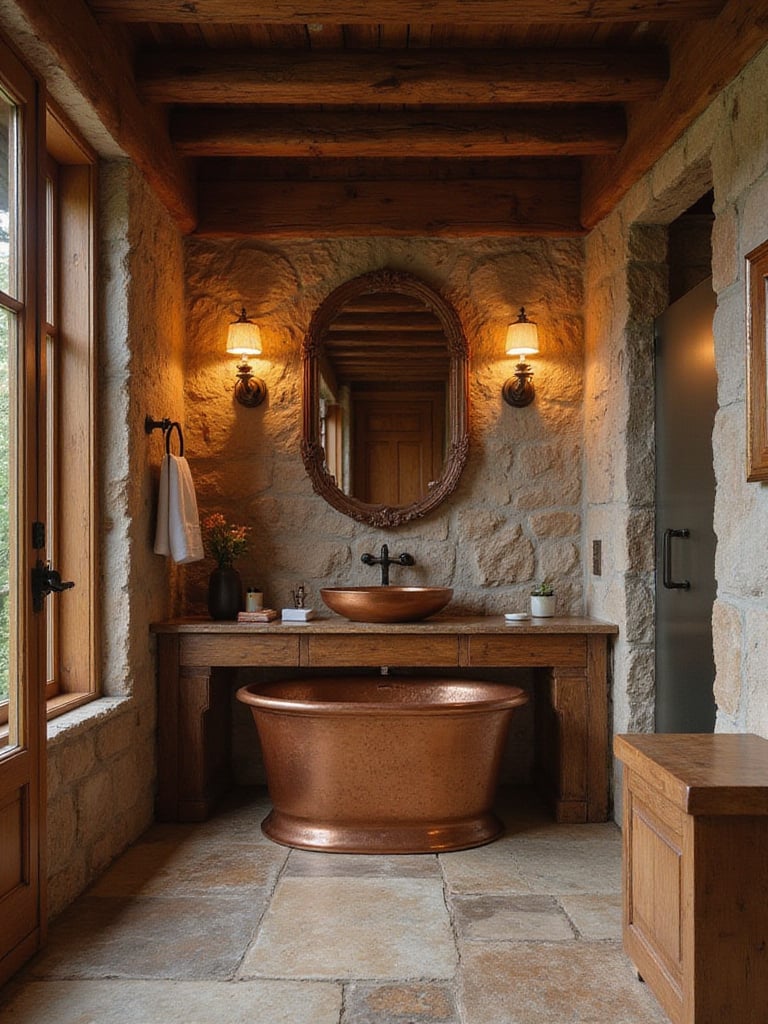
Incorporate copper through various applications depending on budget and impact desires. Major statements include copper bathtubs or vessel sinks. Significant touches involve copper faucets and shower fixtures. Smaller accents might feature copper-framed mirrors, lighting, cabinet hardware, or decorative accessories. The natural patination process—copper’s oxidation creating unique surface layers—aligns perfectly with rustic aesthetics that celebrate natural aging.
If you’ve struggled with similar rooms before, copper might be your missing element. Its warmth instantly transforms cold or sterile bathrooms, and its antimicrobial properties make it both beautiful and practical for rustic bathroom decor that needs to stand up to daily use.
17. Use Cozy Patterns Like Buffalo Check or Plaid
Buffalo Check and Plaid patterns evoke warmth, comfort, and traditional charm that perfectly complement rustic bathroom decor. With historical connections to cabins, lodges, and outdoor living, these patterns instantly create cozy, established atmospheres. Their bold graphic nature provides visual interest without fussiness, while classic color combinations—red/black or earthy tones—seamlessly integrate with rustic palettes.

Strategic placement prevents overwhelming spaces. Rather than covering large areas, focus on specific accent pieces: shower curtains provide excellent focal opportunities, while towels, bath mats, or storage baskets offer smaller pattern introductions. Balance bold patterns with solid neutrals and natural materials to maintain visual harmony.
While designed for the living room, we’ve seen creative uses in bathrooms that transform these traditionally public-space patterns into private sanctuary elements. In rustic bathroom decor, these patterns can reference both Western cabin traditions and the geometric precision found in Eastern textile arts—another opportunity for cultural design fusion.
18. Get Creative with Rustic Towel Racks (Ladder, Pipe)
Ladder and pipe towel racks offer perfect rustic bathroom decor elements through their inherent character. Vintage or distressed wooden ladders evoke history, utility, and handcrafted charm that aligns with rustic design’s raw, unrefined qualities. Industrial pipes—typically black iron or galvanized steel—contribute rugged, utilitarian edge that beautifully complements natural materials. Both provide unique alternatives to standard fixtures.
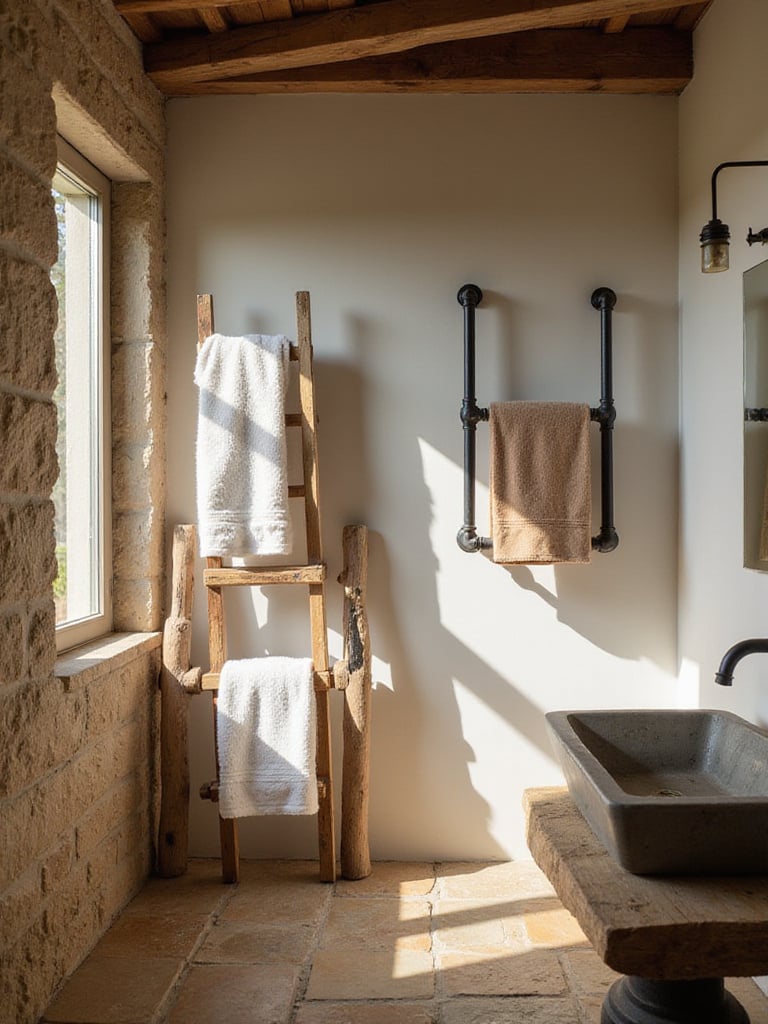
Materials vary by type: ladder racks primarily use wood (reclaimed barn wood or distressed lumber) with raw, sealed, or distressed paint finishes. Pipe racks feature metal piping—commonly black iron, galvanized steel, or copper—often left in natural industrial states or sealed to prevent rusting. Both require consideration for wet towel contact; wood needs water-resistant sealing, while metal may require rust prevention treatments.
The unexpected pairing that always works is combining Eastern minimalism with Western industrial elements. A simple bamboo ladder alongside iron pipe fixtures creates compelling contrast in rustic bathroom decor that honors multiple design traditions while creating something fresh and personally meaningful.
19. Repurpose Old Items for Unique Decor Pieces
Repurposing vintage items adds authentic character to rustic bathroom decor through items with natural aging and history. Ideal candidates include pieces made from durable materials—wood, metal, glass—showing signs of age and use. Consider old wooden ladders, crates, galvanized buckets, plumbing pipes, antique mirrors, vintage tools, and classic glass containers. Their inherent patina and visible history create instant character.
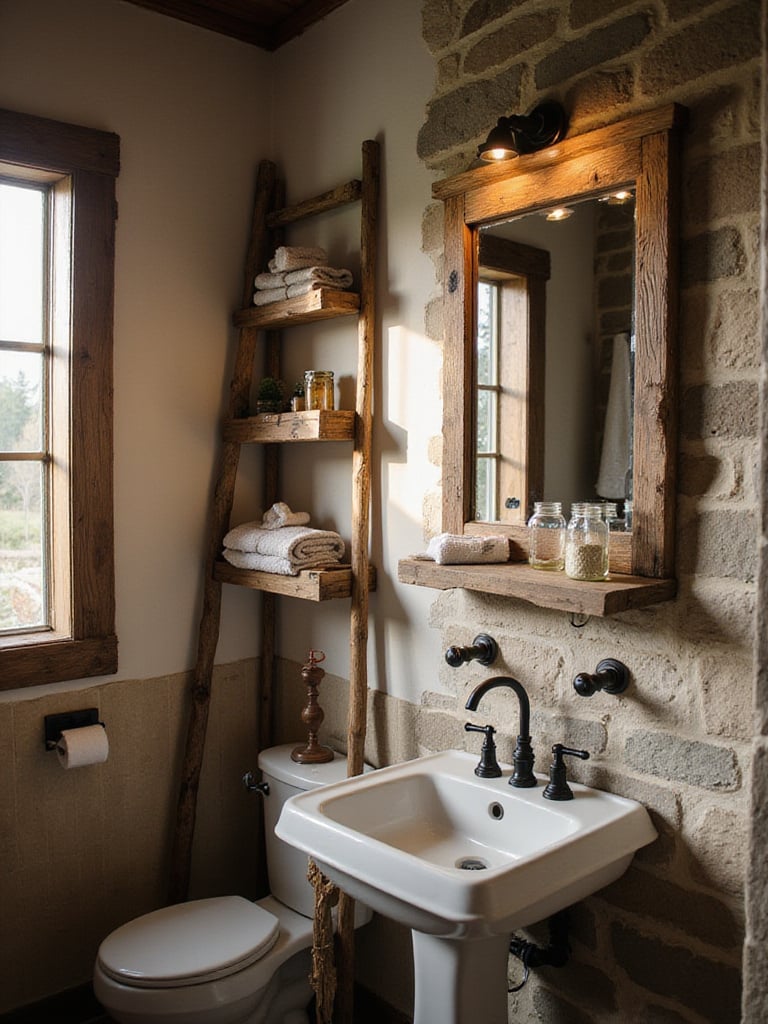
This approach brings authenticity that aligns perfectly with rustic design principles celebrating imperfection, texture, and historical connection. Repurposed items introduce elements that feel grounded and unpretentious, creating spaces that feel genuinely unique rather than mass-produced. They add warmth and lived-in qualities that new items simply cannot replicate.
The artisan collective that creates these pieces often combines influences from multiple cultural traditions. In my design practice, I encourage clients to incorporate meaningful objects from their own heritage into rustic bathroom decor—perhaps a wooden vessel from an Eastern tradition repurposed as a planter, or Western industrial elements reimagined as towel holders.
20. Select Rustic Flooring Like Wood-Look Tile or Stone
Flooring provides essential foundation for rustic bathroom decor through materials that enhance overall aesthetic. While real hardwood offers unmatched warmth, it remains vulnerable to bathroom moisture. Wood-look porcelain or ceramic tile provides visual wood appeal—including varied grain patterns and distressed textures—with complete waterproofing, durability, and minimal maintenance requirements.
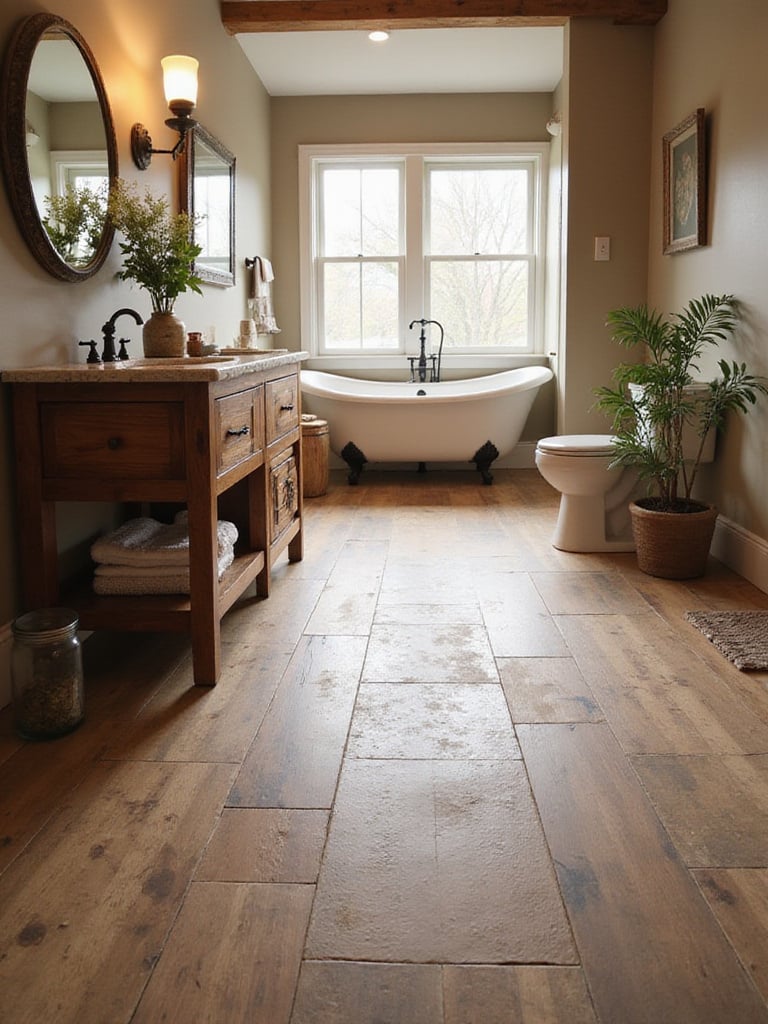
Natural stone offers another excellent option. Slate provides rich earthy colors and naturally cleft surfaces with excellent slip resistance. Travertine contributes warm neutral tones with interesting porous textures. Flagstone brings rugged, irregular shapes for truly organic appearances. Pebble or river rock tiles create naturalistic, spa-like surfaces. All stone requires proper sealing against moisture and staining.
The revival of this classic form comes with a twist in modern rustic bathroom decor. Today’s wood-look tiles offer unprecedented realism while solving practical moisture concerns, while stone installations now incorporate heating elements for comfort—perfect examples of how traditional materials can be adapted for contemporary needs while maintaining authentic character.
21. Add Greenery with Simple, Natural Plants
Plants contribute vital natural elements to rustic bathroom decor, adding organic texture, vibrant color, and living presence. In spaces dominated by hard materials like wood, stone, and metal, plants provide essential softening effects that create more inviting, tranquil environments. Many common houseplants thrive in bathroom humidity, making these spaces ideal locations while potentially improving air quality.
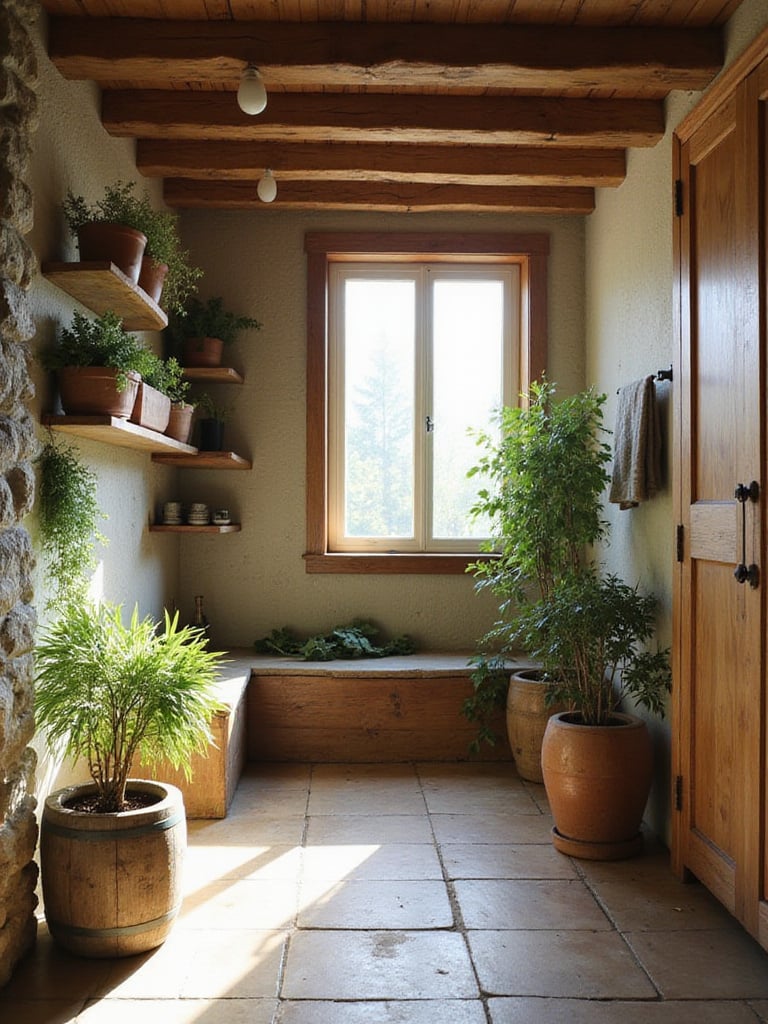
Bathroom-friendly plants that complement rustic aesthetics include Ferns, Snake Plants, Pothos, Spider Plants, ZZ Plants, Cast Iron Plants, and Peace Lilies—all tolerating humidity and varied light conditions. Choose plants with natural, unfussy appearances and place them in complementary containers like terracotta, aged metal, or woven baskets to enhance rustic themes.
As morning light filters through, the texture creates beautiful shadow patterns that bring dynamic energy to rustic bathroom decor. This connection to living things reflects both Eastern design philosophy’s emphasis on nature and Western traditions of bringing the outdoors in—another opportunity for cross-cultural design harmony.
22. Complete the Look with Rustic Hardware and Accessories
The finishing details in hardware and accessories elevate rustic bathroom decor from basic to exceptional. Select materials that appear natural, aged, or handcrafted: wrought iron (matte black or distressed), aged brass or bronze (with patina), distressed or reclaimed wood, copper, and galvanized metal. Avoid highly polished or sleek modern finishes; embrace items showing texture, visible imperfections, or historical references.

Beyond basic fixtures, numerous elements enhance rustic aesthetics: cabinet hardware, towel bars, toilet paper holders, light fixtures, mirror frames, decorative hooks, soap dishes, waste bins, and storage containers from natural materials. Even small details like coordinating switch plates contribute to cohesive design. Subtle metal mixing creates layered authenticity when finishes share similar tones or distress levels.
The craftsmanship reveals itself in details like hand-forged drawer pulls or cabinet knobs made from natural materials. These small but impactful elements complete the rustic bathroom decor story, creating a space that feels thoroughly considered and authentically executed from the largest fixtures to the smallest accessories.
Conclusion: Creating Your Cross-Cultural Rustic Sanctuary
Transforming your bathroom into a rustic retreat transcends mere decoration—it creates a daily sanctuary that speaks to deeper connections with nature, history, and cultural heritage. By thoughtfully blending elements from Eastern and Western design traditions, you can create spaces that feel both grounded in timeless principles and uniquely personal.
The beauty of rustic bathroom decor lies in its flexibility and authenticity. Whether you’re drawn to reclaimed wood vanities, natural stone sinks, textured accent walls, or vintage fixtures, each element contributes to a space that feels warm, inviting, and genuinely yours. By embracing imperfections, celebrating natural materials, and incorporating meaningful cultural touchpoints, you create not just a functional room but a retreat that nurtures well-being through thoughtful design.
As you implement these ideas, remember that the most successful rustic spaces tell a story—your story. Let your bathroom become a place where East meets West, where old meets new, and where every element contributes to a harmonious whole that reflects your unique perspective on what makes a house truly feel like home.
